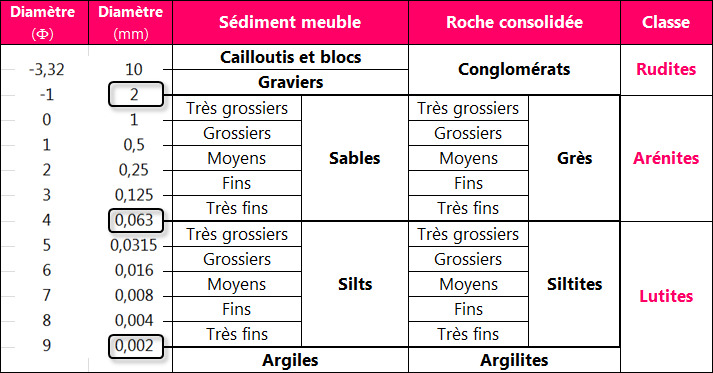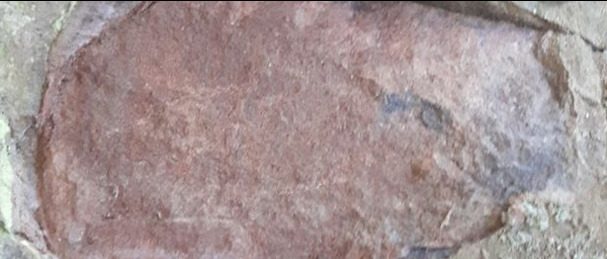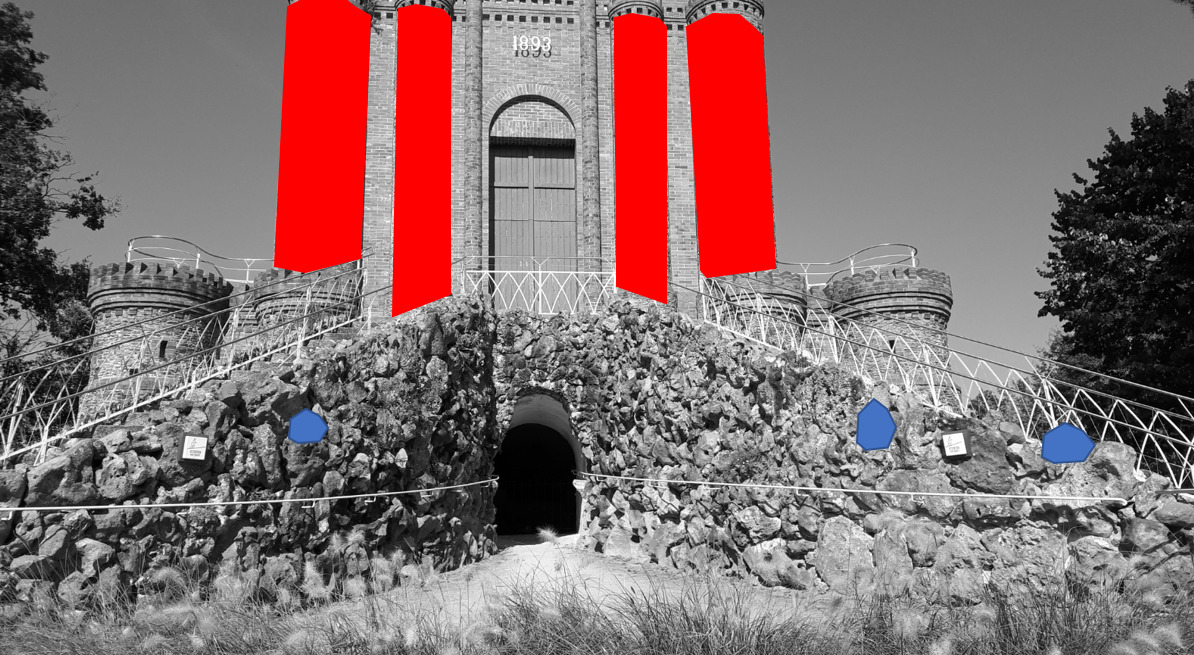
La Earthcache / The Earthcache
► Contexte géologique local
Le site de la Salette, à l'Est de la Rabaletière, prend place sur un ensemble géologique du socle hercynien, la formation de Bourgneuf de l'unité de Chantonnay (Cambrien supérieur).

Il s'agit d'un ensemble composite de formations métamorphiques issues de protolithes détritiques et volcanoclastiques, des Métapélites et des Métagrauwackes.
Le métamorphisme désigne l'ensemble des transformations subies par une roche (ou protolithe) sous l'effet de modifications des conditions de température (T) et de pression (P).
Ces transformations minéralogiques, texturales, chimiques ou structurales amènent à une réorganisation des éléments dans la roche et à une recristallisation des minéraux à l'état solide.
► Métapélites, métamorphisme détritique
Les métapélites sont des formations métamorphiques issues de la transformation d'une roche sédimentaire détritique à grains très fins (silteuse ou argileuse).
La classification d'une roche sédimentaire détritique se base sur la taille de ces composants (classification granulométrique de Wentworth).

La roche obtenue par métamorphisation se caractérise par une foliation et une schistosité très fines et une texture lisse (grains invisibles à l'oeil nu).
Selon les conditions de pression et de température, les métapélites prennent différents faciès métamorphiques (association de minéraux tous stables dans les mêmes conditions P-T).

Il existe 4 grands types de chimie pour les faciès métamorphiques P-T dérivées de la séquence pélitique (argileuses) :
- Métamorphisme "Basse Pression/ Basse température" : faciès des "schistes verts", roche litée dont la couleur verdâtre est due à la présence de chlorite et d'épidote.
- Métamorphisme "Haute Pression/ Basse température" : faciès des schistes bleus, roche litée appelée schistes à glaucophane car ce minéral est à l'origine de la couleur bleue de la roche.
- Métamorphisme "Basse Pression/ Haute température" : faciès à "cornéenne", roche cohérente très dure brune foncée à noire caractéristique d'un métamorphisme de contact.
- Métamorphisme "Haute Pression/ Haute température" : faciès à "éclogite", roche cohérente non litée rouge et verte du fait sa composition en omphacite et grenat.

► Métagrauwackes, métamorphisme d'un protolithe volcanoclastique
Les Métagrauwackes tufacés sont issus de la transformation de formations détritiques volcanoclastiques et se présentent en une alternance d'épaisses couches de grauwackes gréseux entrecoupées de zones lenticulaires de conglomérats à graviers ou petits galets.
L’origine volcanoclastique du matériel détritique s’exprime par la fréquence des cristaux de quartz à cachet pyroclastique et l’abondance de cristaux de feldspath subautomorphes.
Ces formations sont issues de l'accumulation par action mécanique (vent ou eau) de fins matériaux volcaniques formant des dépôts englobant parfois des éléments plus gros.
Sous l'action de l'eau, ces téphras se consolident en tufs par oxydation de leur minéraux ferromagnésiens, donnant une couleur sombre lie-de-vin à noire à cette matrice.
Comme pour les métapélites, la taille des sédiments conditionne la nature de la roche :
- Si les clastes sont inférieurs à 2 mm, on parle de Métagrauwackes gréseuses se présentant sous la forme d'une roche homogène lie-de-vin à grains grossiers.

- Si les plus gros clastes cimentés sont supérieurs à 2 mm, on parle alors de conglomérats à graviers ou à blocs.
Parmi ces gros éléments cimentés, on peut observer des éléments d’origine volcanique (fragments de lave rhyolitique ou basaltique) ou non (quartz filoniens, silex ou cherts).

► Local geological context
The site of La Salette, to the east of La Rabaletière, takes place on a geological set of the Hercynian base, the Bourgneuf formation of the Chantonnay unit (Upper Cambrian).
It is a composite set of metamorphic formations resulting from detrital and volcaniclastic protoliths, Metapelites and Metagrauwackes.
Metamorphism refers to all the transformations undergone by a rock (or protolith) under the effect of changes in temperature (T) and pressure (P) conditions.
These mineralogical, textural, chemical or structural transformations lead to a reorganization of the elements in the rock and to a recrystallization of minerals in the solid state.
► Metapelites, detrital metamorphism
Metapelites are metamorphic formations resulting from the transformation of a very fine-grained detrital sedimentary rock (silty or clayey).
The classification of a detrital sedimentary rock is based on the size of these components (Wentworth particle size classification).

The rock obtained by metamorphosis is characterized by a very fine foliation and schistosity and a smooth texture (grains invisible to the naked eye).
Depending on the pressure and temperature conditions, the metapelites take on different metamorphic facies (association of minerals all stable under the same P-T conditions).
There are 4 main types of chemistry for P-T metamorphic facies derived from the pelitic sequence (clayey):
- "Low Pressure / Low Temperature" metamorphism: facies of "green schists", bedded rock whose greenish color is due to the presence of chlorite and epidote.
- "High Pressure / Low temperature" metamorphism: facies of blue schists, bedded rock called glaucophane schists because this mineral is at the origin of the blue color of the rock.
- "Low Pressure / High Temperature" metamorphism: "corneal" facies, very hard dark brown to black coherent rock characteristic of contact metamorphism.
- "High Pressure / High Temperature" metamorphism: "eclogite" facies, unlit coherent red and green rock due to its composition in omphacite and garnet.
► Metagrauwackes, metamorphism of a volcaniclastic protolith
Tuffaceous Metagrauwackes result from the transformation of detrital volcaniclastic formations and occur in an alternation of thick layers of sandstone grauwackes interspersed with lenticular zones of conglomerates with gravels or small pebbles.
The volcaniclastic origin of the detrital material is expressed by the frequency of pyroclastic quartz crystals and the abundance of subautomorphic feldspar crystals.
These formations result from the accumulation by mechanical action (wind or water) of fine volcanic materials forming deposits sometimes including larger elements.
Under the action of water, these tephras consolidate into tuffs by oxidation of their ferromagnesian minerals, giving a dark wine-red to black color to this matrix.
As with metapelites, the size of the sediments determines the nature of the rock:
- If the clasts are less than 2 mm, we speak of sandstone Metagrauwackes in the form of a homogeneous, wine-colored, coarse-grained rock.
- If the largest cemented clasts are greater than 2 mm, then we speak of gravel or block conglomerates.
Among these large cemented elements, we can observe elements of volcanic origin (fragments of rhyolitic or basaltic lava) or not (vein quartz, flint or cherts).
► Sources bibliographiques / Bibliographical sources
Les Questions / The Questions
La lecture attentive du descriptif de la cache, ainsi qu'une observation des éléments de terrain et un peu de déduction sont normalement suffisants pour répondre aux questions de cette EarthCache.
A careful reading of the description of the cache, as well as observation of terrain features and some deduction is usually sufficient to answer questions of this EarthCache.
Questions pour valider :"Méta-Roches à la Salette"
Questions to validate: "Meta-Rocks at La Salette"
Point 1 : N 46° 51.848 W 001° 14.729
- Question 0 : Prenez une photo de vous ou d'un élément vous identifiant dans le site de la Salette, mais pas le WP1.
Cette photo devra au choix nous être transmise avec les réponses ou être ajoutée à votre log.
- Question 0 : Take a photo of yourself or of an element identifying you in the La Salette site, but not in WP1.
This photo must either be sent to us with the answers or added to your log.
Après avoir monté le chemin de croix, vous voici devant une reproduction de grotte surmontée d'un imposant édifice avec la date 1893 dessus (photo WP1).
After having climbed the Stations of the Cross, here you are in front of a reproduction of a cave surmounted by an imposing building with the date 1893 on it (photo WP1).

Deux ensembles de zones sont à observer :
- Les zones bleues masquant quelques blocs qui bordent le chemin menant à la "grotte".
- Les zone rouges masquant un second type de roches utilisé dans l'édifice lui même.
Two sets of zones are to be observed:
- The blue areas hiding some blocks that line the path leading to the "cave".
- The red areas hiding a second type of rock used in the building itself.
Etudiez les caractéristiques des roches sous les zones, déduisez-en leur nature puis répondez aux questions ci-dessous, en rattachant les questions à la nature des roches observées :
Study the characteristics of the rocks under the zones, deduce their nature and then answer the questions below, relating the questions to the nature of the rocks observed:
--> Sur la zone où vous observez des Métagrauwackes tufacés :
--> In the area where you observe Tuffaceous Metagrauwackes:
- Question 1 : Décrivez la couleur de la matrice et déduisez-en l'origine de cette couleur.
- Question 1 : Describe the color of the matrix and deduce the origin of this color.
- Question 2 : En fonction de la taille des plus gros éléments, quel est le type de formation détritique qui a été métamorphisé ? Quelle est la nature géologique de ces éléments ?
- Question 2 : Based on the size of the larger pieces, what type of detrital formation was metamorphosed? What is the geological nature of these elements?
--> Sur la zone où vous observez des Métapélites :
--> In the area where you observe Metapelites :
- Question 3 : Décrivez la couleur de la roche saine et déduisez en le faciès métamorphiques P-T.
- Question 3 : Describe the color of the rock and deduce the metamorphic facies P-T.
- Question 4 : Observez et caressez la roche pour en déduire la classe granulométrique selon Wentworth de son protolithe.
- Question 4 : Observe and stroke the rock to deduce the size class according to Wentworth of its protolith.
Point 2 : N 46° 51.827 W 001° 14.742
Vous voici devant un affleurement de la roche supportant l'ensemble du site de la Salette (photo WP2).
Here you are in front of an outcrop of the rock supporting the entire La Salette site (photo WP2).

- Question 5 : Décrivez l'affleurement sous la zone verte et déduisez-en pour quelle construction observée au WP1 cette roche a été utilisée.
- Question 5 : Describe the outcrop and deduce for which construction observed in WP1 this rock was used.
Vous pouvez vous loguer sans attendre notre confirmation,
mais vous devez nous envoyer les réponses en même temps soit par mail via notre profil (
fafahakkai), soit via la messagerie geocaching.com (Message Center).
S'il y a des problèmes avec vos réponses nous vous en ferons part.
Les logs enregistrés sans réponses seront supprimés.
You can log this cache without waiting for our confirmation, but you must send us the answers at the same time, by e-mail via our profile (fafahakkai) or by the system of Message Center of geocaching.com.
If there is a problem with your answers we will notify you. The logs recorded without answers will be deleted.
Rappel concernant les « Earthcaches »: Il n'y a pas de conteneur à rechercher ni de logbook à renseigner. Il suffit de se rendre sur les lieux, de répondre aux questions ci-dessus et de nous renvoyer les réponses.
Reminder concerning "Earthcaches": there is neither a container to look for nor a logbook to sign. One need only go to the location, answer to the differents questions and send us the answers.